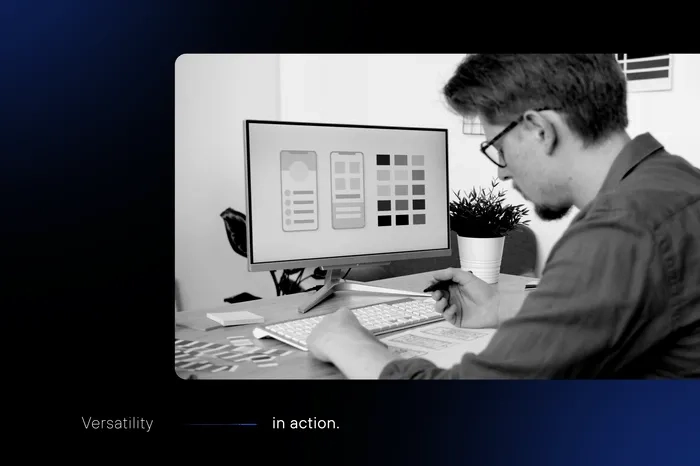
You’ve invested a significant amount of capital in a new website, built with the latest design trends, yet it’s not delivering the business results you expected. It’s a frustrating but all-too-common scenario. Many companies create visually stunning digital assets that, however, fail to convert visitors into customers, generate qualified leads, or sustain long-term business growth.
The problem rarely lies in the technology or design alone. It often stems from the lack of a strategic vision that connects aesthetics with performance. This is where the concept of website design companies evolves. They are no longer just service providers building websites; they have become strategic partners responsible for developing a true digital asset that drives business growth.
In this article, we’ll explore how this transformation takes shape and what you should look for in a partner to ensure your next digital project is a real success.
Scope of Action
First and foremost, it’s essential to understand that modern website design companies must go far beyond creating a visually appealing site. They work across multiple areas of your business’s digital ecosystem, from information architecture and user experience/interface design (UX/UI) to system integrations and automations that make your site efficient, fast, secure, and well-positioned in search engines.
In other words, this new generation of companies is fully multidisciplinary. They combine design, technology, digital marketing, user data analysis, and agile methodologies to keep your website constantly updated and performing at its best. They are the specialists behind the scenes, ensuring every part of your digital project runs smoothly and independently, like clockwork.
This journey begins long before the first pixel is designed. To get started, website design companies immerse themselves in your business, learn about your customers, analyze your competitors, and define clear project objectives. Only then can they build a website that acts as a true extension of your brand, one that generates real results and accelerates growth.
Here’s how these companies typically work in practice and the types of deliverables you can expect:
- Digital Strategy Consulting: They perform a complete business diagnosis, map the user journey, research international benchmarks, conduct Design Thinking workshops, and define tailored project requirements.
- Custom Development: They design your visual identity, create exclusive layouts, build a solid semantic structure, develop bespoke functionalities, and integrate resources such as e-commerce, CMS platforms, intelligent landing pages, CRMs, and automation tools.
- Continuous Management and Support: They monitor website performance, provide technical SEO assistance, track analytics, and continuously evolve your project, integrating new solutions as your needs grow.
For small businesses, the approach may be more streamlined, focused on conversion, easy integration with payment systems, Google Business Profile, WhatsApp, and marketplaces, ensuring even local brands achieve an efficient digital presence that keeps them connected to their customers.
Also read: Before hiring: 10 characteristics of a good web company
Development and Technology: The Invisible Foundation for Success
So far, we’ve talked about the importance of combining design, strategy, and performance, but it’s equally important to understand what powers this structure behind the scenes. Development and technology are the invisible foundation that ensures your website’s concept works seamlessly in practice, maintaining scalability and sustainability.
By now, you’ve realized that choosing an appealing visual design alone isn’t enough. Behind every high-performing website lies a complex network of code, frameworks, APIs, and integrations that must be carefully aligned to prevent limitations down the road.
For instance, modern frameworks such as React and Vue have become prominent for enabling fast and flexible interfaces, which directly impact user experience and business outcomes.
Moreover, selecting the right system to manage your website’s content (the CMS) is just as strategic as the design itself. Platforms like WordPress, Drupal, and Webflow determine how simple and autonomous your team will be when updating content, adding new features, or integrating with essential business systems. This decision directly influences your project’s agility and scalability.
Talk to a specialist about your website project
Why Does This Matter for Your Digital Project?
Because custom development and the right technology stack are what ensure your digital presence is not only visually striking but also functional, adaptable to market changes, and ready to grow with your brand. This approach prevents the need for complete rebuilds in the near future due to technical constraints, turning your website into a long-term competitive advantage.
What Technological Models Exist?
Custom Projects: Perfect for businesses that want total control and personalization. While the investment and timeline are greater, the final result is a unique and robust digital asset designed to scale alongside your growth, integrating vital systems like ERPs and CRMs.
Minimum Viable Product (MVP) and Modular Solutions: Ideal for those aiming to reduce costs and speed up product launches or relaunches. Template-based or visual builder models (such as Webflow or Shopify) are excellent options, allowing quick adjustments as business needs evolve.
Active Management and Ongoing Support: Regardless of the model, a good website design company continuously monitors your website, updating technologies, improving security, and optimizing performance to ensure it never becomes outdated.
What Sets Great Website Design Companies Apart?
Choosing the right website design company shouldn’t be a rushed decision. Every effective website is built upon a series of unseen details that directly influence the success of the entire project.
First, the company must have well-documented processes and full project control. Every stage, from the initial briefing and wireframing to development and testing, should be recorded and validated. This structure prevents surprises and allows you to follow progress with transparency and confidence.
Another essential factor is having a cohesive, multidisciplinary team. Designers, developers, UX/UI specialists, digital strategists, and copywriters need to work in sync to deliver layouts, content, and functional strategies that elevate results.
Clear governance is also critical: transparent contracts, realistic scopes, guaranteed intellectual property rights, and well-defined deliverables, all aligned with what was agreed upon, prevent future conflicts and ensure accountability.
Finally, the best website design companies stay ahead of global trends. They draw inspiration from international design standards, prioritize accessibility, optimize for mobile devices, perform continuous A/B testing, and base key decisions on real data, making sure your website always stays ahead of the curve.
Basic Criteria for Choosing the Right Partner
Reviewing the Portfolio
It’s important to assess the diversity of delivered projects, how well they align with market segments, the technical solutions implemented, usability standards, and, most importantly, the measurable impact these projects have achieved for their clients.
Transparency and Security as Core Principles
Avoiding frustration starts with clear agreements: defining boundaries, objectives, and a transparent roadmap while fully understanding the project’s governance. Ownership of source code and digital assets must be guaranteed in the contract to ensure you remain independent for future updates.
Website security also demands attention. Make sure the company implements automatic backup policies, regular updates, continuous monitoring, and strict access control to protect your digital assets from attacks or data loss.
Support and Continuous Evolution: Long-Term Partnerships
A reliable partner doesn’t disappear after the website goes live. Continuous performance monitoring, bug fixes, feature upgrades, and strategic adaptations ensure your site stays current and aligned with your business goals, ready to meet evolving market demands.
With these criteria in mind, choosing the right website design company becomes a safe, business-aligned decision that drives long-lasting and measurable results.
Read also: Why Do Professional Website Development Projects Fail?
Differences Between Traditional and Innovative Web Design
Web design has advanced rapidly in recent years, driven by emerging technologies, changing user behaviors, and increasingly strict regulatory requirements. These shifts go far beyond aesthetics, they directly influence fundamental aspects such as performance, accessibility, and the overall user experience.
Traditional Web Design: Limitations and Conventional Structure
For many years, traditional web design followed a static, predefined layout approach. Projects were primarily built for desktop, with mobile adaptations added later, often resulting in poor navigation and slow response times on smartphones.
Content management was manual and disconnected from other platforms, limiting update agility. Security measures, while present, were basic and typically reactive. Once the site was delivered, the engagement often ended, with no continuous support or proactive performance monitoring.
Innovative Web Design: Adaptation and User-Centered Experience
Modern web design, on the other hand, centers on personalization and adaptability, reflecting the unique DNA of each brand. The mobile-first principle drives the process, ensuring a seamless mobile experience enhanced by subtle microinteractions that engage users naturally.
Content management has become dynamic and automated thanks to the use of APIs, headless CMS, and multichannel integrations, enabling real-time updates synchronized across different digital platforms. Advanced security and scalability solutions now include automated backups and ongoing technical evolution programs.
Project monitoring is continuous and data-driven, involving constant metric analysis, performance tuning, security updates, and iterative improvements based on real user data.
Talk to one of our specialists and get all your questions answered
Performance and Universal Accessibility in Focus
One of the strongest pillars of innovative web design is fast loading speed. Slow websites negatively affect user experience, drive visitors away, and damage search engine rankings, all of which reduce conversion rates.
To ensure high performance even on unstable or slow mobile networks, advanced techniques like lazy loading, image optimization, modern formats such as WebP, and code minimization are essential. Another important factor is cross-browser compatibility, which guarantees consistent visual and functional performance across browsers like Chrome, Firefox, Edge, and Safari.
Responsiveness, meanwhile, must go beyond “working on mobile.” It’s about fluidly adapting the layout across all devices, from smartphones and tablets to desktops and even smart TVs. Innovative design rethinks positioning, typography, menus, and user interactions for each viewing context, ensuring natural and efficient navigation on any screen.
Finally, universal accessibility has become a vital requirement, both to expand audience reach and comply with legal standards in many markets. It ensures that people with disabilities can navigate effectively, with proper color contrast, keyboard navigation, screen reader support, and alternative image descriptions.
Compliance with international accessibility standards like WCAG 2.1 is essential to create truly inclusive digital experiences.

Expand your knowledge: Stages and impacts of User Experience Design for websites
Comparative Table: Traditional vs. Innovative Web Design
| Aspect | Traditional Web Design | Innovative Web Design |
|---|---|---|
| Layout and Visuals | Predefined, limited flexibility | Unique, customized, and aligned with the brand’s DNA |
| Mobile | Late adaptation, with restrictions | Mobile-first approach, focused on microinteractions |
| Content Management | Manual and static | APIs, headless CMS, and multichannel integrations |
| Security and Scalability | Basic, reactive to incidents | Advanced, proactive, with automated backups and continuous evolution |
| Project Monitoring | Ends at launch | Ongoing support, metric analysis, and continuous improvement |
This comparison highlights how process, technology, and long-term support drastically affect a website’s effectiveness, user experience, and return on investment in today’s digital landscape.
The Future of Web Design
As we move toward 2026 and beyond, web design will continue to evolve with stronger integrations of Artificial Intelligence, enabling real-time personalization and automatic adaptation to each user’s needs. Technologies such as Augmented Reality (AR) and Virtual Reality (VR) They are also beginning to shape immersive experiences in the digital environment.
Sustainability is gaining importance as well, prioritizing design practices that emphasize energy efficiency, optimized loading speed, and responsible use of visual and functional resources. Moreover, inclusive design remains a crucial ethical and legal foundation, expanding brand relevance and social impact in the digital era.
Don’t Wait Any Longer
Website design companies are key agents of innovation in the digital environment. They serve as strategic partners capable of delivering powerful websites that express brand identity, accelerate business growth, enhance performance, protect data, and evolve with emerging technologies and user behaviors.
If you’re looking for a partner that combines deep technical expertise, strategic vision, and strong governance, Dexa is ready to help. With over two decades of experience and a solid portfolio, Dexa integrates experience design, advanced technological development, digital marketing, and Artificial Intelligence to deliver end-to-end, results-driven solutions.
By choosing Dexa, businesses embark on a transparent and collaborative journey rooted in innovation and continuous support, transforming their website into a sustainable competitive advantage, ready to face the challenges and seize the opportunities of the digital future.
